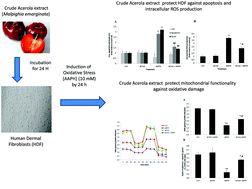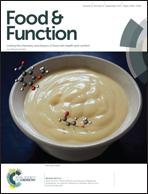The protective effect of acerola (Malpighia emarginata) against oxidative damage in human dermal fibroblasts through the improvement of antioxidant enzyme activity and mitochondrial functionality
Abstract
Acerola fruits (Malpighia emarginata DC.) from the central region of Cuba were analyzed to determine their chemical composition and protective capacity against oxidative damage using an in vitro human dermal fibroblast (HDFa) model. The chemical composition analyses showed a high content of vitamin C, total polyphenols, β-carotene and folates in the acerola fruit. From the HPLC-DAD/ESI-MSn analyses, two anthocyanins (cyanidin 3-O-rhamnoside and pelargonidin 3-O-rhamnoside), three hydroxycinnamoyl derivatives (caffeoyl hexoside, dihydrocaffeoylquinic acid and coumaroyl hexoside) and fifteen flavonols (mostly glycosylated forms of quercetin and kaempferol) were detected. HDFa were pre-incubated with an acerola crude extract (ACExt) and subsequently subjected to oxidative stress induced by AAPH. Apoptosis, intracellular ROS and the biomarkers of lipid and protein oxidation significantly increased after inducing stress, while the activities of the antioxidant enzyme catalase and superoxide dismutase and mitochondrial functionality were markedly affected. However, ACExt was able to protect against oxidative damage through decreasing apoptosis, intracellular ROS levels and lipid and protein damage, besides improving antioxidant enzyme activities and mitochondrial functionality. The obtained results support acerola fruits as relevant sources of functional compounds with promising effects on human health.



 Please wait while we load your content...
Please wait while we load your content...